AN ESSAY ON THE HISTORY OF THE URAL SOCIETY OF VETERINARIANS
Very little is known about the first voluntary association of veterinarians in Kazakhstan, founded at the end of the nineteenth century in Uralsk. In addition, the exact date of its organization is still unknown [1, 2].
For the first time, the Ural Veterinary Society is mentioned in the dissertation work of the founder of the veterinary history of Kazakhstan, S.K. Kozhakin. At the same time, the author, without possessing authentic historical documents, claims that it is “since 1893 that regional veterinary societies have been created one after another in Kazakhstan” [3]. These data of the author were published 21 years later in the book “Veterinary Medicine of Kazakhstan” [4].
The proposed article attempts to historically reconstruct the named veterinary society on the basis of archival and literary sources, to reveal the complex processes of its formation and development at the turn of the nineteenth and twentieth centuries.
The initiators of the creation of the society were veterinarians of the Ural region Artur Kasparovich Kepp, Pavel Markovich Makarov and M.A. Laschenko. Their proposal was met with resistance from the head of the veterinary department of the Ural region, regional veterinarian, collegiate adviser Anatoly Petrovich Petrovsky (Figure 1), who stated “that this case will not happen” [5].
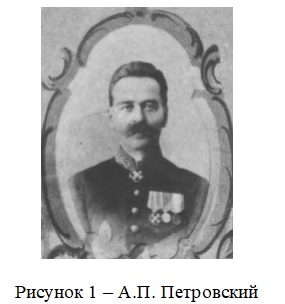
Despite the obstacles, the draft charter of the Ural Society of Veterinarians (UOVV) prepared by the initiators was approved on April 8 (20), 1898 on behalf of the Minister of Internal Affairs of Russia, Comrade Minister, Senator, Baron Ixkul and certified on behalf of the acting Chairman of the Veterinary Committee Rozhnov [6].
The purpose of the society, according to section 1 of the charter, was to study the epizootic situation and diseases of domestic animals in the region, as well as to study local conditions affecting the spread of infectious diseases of domestic animals and the development of veterinary static data on diseases [6, p.1].
In accordance with section 4 of the UOVV charter, the company was given the right to prepare measures for the government of Russia to combat the mass death of livestock in the region [5, p.2].
On the basis of § 30 of the charter, the company had the right to publish the “Proceedings of the Ural Society of Veterinarians”, separate appendices to these works and minutes of meetings of the UOVV [6, p.7].
The UOVV was established at the general meeting of veterinarians on June 2-3 (14-15), 1898, consisting of 14 full members [7].
M.A. Laschenko was elected the first chairman of the UOVV by secret ballot, comrade of the chairman P.M. Makarov, secretary Andrey Alexandrovich Dudukalov, treasurer-librarian Alexander Nikolaevich Ryazantsev [7, L.5].
On June 2 (14), 1898, during the first day of the meeting of the general meeting of veterinarians of the Ural region, after the chairman and a comrade of the chairman were elected, A.P. Petrovsky and A.I. Clerikov unexpectedly left the ranks of the UOVV (Figure 2), thus, the elections of the secretary and treasurer-librarian took place without their participation [7, L. 5].
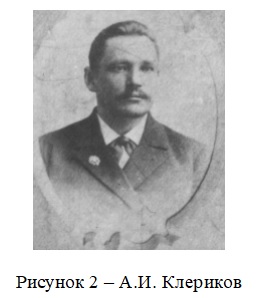
Such an act by A.P. Petrovsky can probably be regarded as a sign of dissatisfaction that he, the head of the veterinary service of the region, was not elected chairman of the UOVV. This is evidenced by the speech read by the chairman of the USOV M.A. Leshchenko on July 1 (13), 1898 at the general meeting of the members of the society and then published in the form of an information leaflet [5, l.1-2]. On July 1 (13), 1899, instead of A.A. Dudukalov, who left on a business trip to remote areas of the Ural region, A.N. Ryazantseva, Alexey Ivanovich Barbar was elected secretary (Figure 3), Ilya Ilyich Kadykov was elected treasurer-librarian [8]
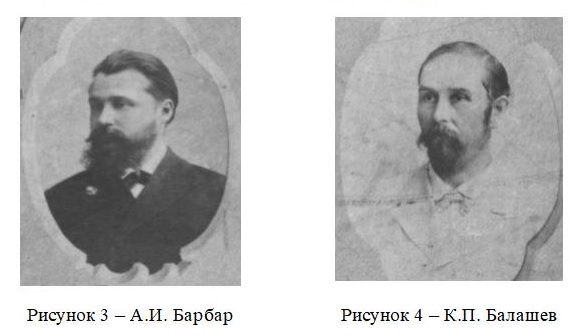
On March 5 (18), 1904, the leadership of the UOVV was re-elected. Konstantin Petrovich Balashev was elected Chairman of the society (Figure 4), P.M. Makarov was re-elected comrade of the chairman, A.I. Barbar was also re–elected secretary, Pavel Konstantinovich Bizyanov was treasurer-librarian (Figure 5) [9].
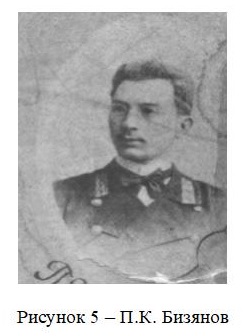
On February 28, 1914, a new charter was adopted according to the old style of the UOVV. It is very important to note the fact that in accordance with § 29 of the charter of the UOVV in 1914, the chairman of the society could be a person “with a scientific veterinary degree” [10].
On March 18 (31), 1914, the UOVV resumed its activities. In accordance with the new charter, Efim Petrovich Nikolsky was elected chairman of the UOVV, Alexey Ivanovich Barbar was a comrade of the chairman, Ivan Ivanovich Bogoslovsky was treasurer, Alexander Matveevich Koenigshatz was secretary [11].
The last meeting of the UOVV was held on September 4, 1918. It was chaired by A.I. Barbar. At the meeting, 4 veterinarians were elected by secret ballot as members of the UOVV and other organizational issues were resolved [12].
During the 20 years of its existence (1898-1918), the UOVV held about 40 meetings, at which the following reports were discussed:
“Foot-and-mouth disease in the Kalmykovsky district of the Ural region, its consequences and the fight against it” (auth. Julian Mikhailovich Vlasevich (Figure 6), 1899);
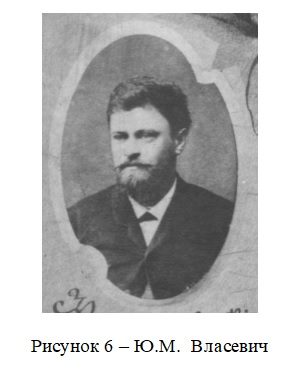
“The value of intravenous anti-rabies vaccinations according to the method of Dr. Krasnitsky” (author I.I. Kosmodamiansky (Figure 7), 1904);
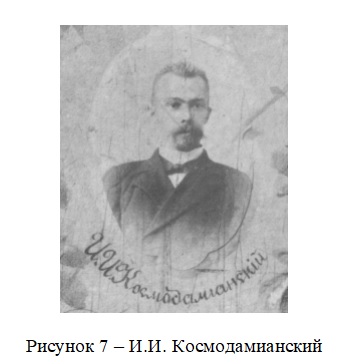
“Veterinary and sanitary essay of the mountains. Tashkent according to the latest data” (author I.M. Kovalevsky, 1905);
“Technique of anti-plague vaccinations of cattle by the combination method” (author I.M. Kovalevsky, 1905);
“On the allocation of safe places for animal cemetery in settlements and rational cleaning of corpses” (author K.P. Balashev, 1905);
“Foot-and-mouth disease in a horse” (author Y.M. Vlasevich, 1906);
“On tracheotomy in a cow with laryngeal edema” (author I.I. Bogoslovsky, 1906);
“Report on a case of rabies in animals in the village of Slalikhinskaya” (author I.I. Bogoslovsky, 1906.);
“Pyroplasmosis of horses in the Ural region (in Kazakh “sarah-aura” – “yellow disease”)” (author A. Golyakhovsky, 1914);
“On foot-and-mouth disease vaccinations according to the method of professor A.V. Dedyulin” (author A.I. Barbar, 1917);
“Foot-and-mouth disease (Cossack name “pagan”, Kazakh name “ausyl”) and the fight against it with vaccinations in the ear according to the method of Professor A.V. Dedyulin” (author A.I. Barbar, 1917) [13, 14, 15, 16, 17, 18, 19, 20,21].
The UOVV prepared brochures and information leaflets on measures to combat infectious diseases of domestic animals “in Russian and Kazakh for free distribution to the population” of the region [20, L.15].
Part of the protocols of the UOVV was published in the journal “Bulletin of Public Veterinary Medicine” [22].
8 (March 21, 1906 I.I. Kosmodamiansky appealed to The Board of the UOVV with a request to allocate funds for the publication of annual reports of the Ural Central (Veterinary) Bacteriological Laboratory [23].
The UOVV commission, consisting of I.I. Bogoslovsky, I.I. Kosmodamiansky, P.M. Markov and Dmitry Semyonovich Ruzhentsov, compiled a list of first-aid kits for fishing farms in 1906 [24].
In 1914, the rules for combating SAP in the Ural region were revised [11, l.350].
UOVV conducted active business correspondence with the Society of Veterinarians at the Kazan Veterinary Institute, the Kharkov Veterinary Institute and the Oryol Veterinary Society [6].
The Veterinary Department of the Ministry of Internal Affairs of Russia applied to the UOVV for methodological assistance in reviewing the list of medicines not included in the Russian Pharmacopoeia and issuing an appropriate conclusion [26,27].
In April 1914, the society received an official invitation from London from the Secretary General of the Organizing Committee of the X International Veterinary Congress, with a request to send a report and select a delegate from the UOVV to participate in this congress [28]. This was a great recognition of the achievements of the UOVV in the development of veterinary knowledge.
From its modest means, the UOVV provided financial assistance to needy students of the Kharkiv Veterinary Institute [29].
Some members of the UOVV subsequently became prominent figures in science and the state.
I.I. Kadykov, a member of the board of the UOVV, became a famous veterinary surgeon, professor, doctor of veterinary sciences, he wrote a textbook for veterinary universities “General Surgery”, he is the author of many methods of surgical treatment of animals [30].
I.I. Kosmodamiansky, a member of the UOVV, was elected in 1907 as a deputy of the II State Duma of Russia from the Ural region [3, pp.284-285].
It should be emphasized that in S.K. Kozhakin’s dissertation “The History of veterinary medicine in Kazakhstan” the surname of I.I. Kosmodamiansky was printed with distortion [3, pp. 284-285], which was then, without correction, published in the fundamental book “Veterinary Medicine of Kazakhstan” [4, pp. 32-33].
With the outbreak of the civil war and the Bolsheviks coming to power in the region, the UOVV was liquidated [31].
Conclusion:
Based on authentic historical documents, it has been established that the first voluntary association of veterinarians in Kazakhstan was established in 1898, and not in 1893, as previously stated in the literature.
LITERATURE:
- Veterinarnaya enciklopediya.-Tom 4. – M., 1973.-S.543-544.
- Nikitin I.N., Kalugin V.I. Istoriya veterinarii.- M., 1988.-S.76-77.
- Kozhakin S.K. Istoriya veterinarii v Kazahstane: Dis. … kand. vet. nauk // NI vet. inst. Kaz. filiala VASKHNIL.-Alma-Ata, 1949.-624 s.
- Veterinariya Kazahstana. – Alma – Ata, 1970.-487 s.
- CGA RK. F. 827. Op.1.D.1. L.1-4 ob.
- Ustav Ural’skogo obshchestva veterinarnyh vrachej. – Ural’sk, 1898.-11 s.
- CGA RK. F. 827 . Op.1.D.1.L. 5-5 ob.
- CGA RK. F. 827 . Op.1.D.1.L. 18-19.
- CGA RK. F. 827 . Op.1.D.2.L. 29-30.
- CGA RK. F. 740 . Op.1.D.1.L. 64-67 ob.
- CGA RK. F. 700 . Op.1.D.18.L. 350.
- CGA RK. F. 827 . Op.1.D.3.L. 59-60.
- CGA RK. F. 827 . Op.1.D.1.L. 9-17 ob.
- CGA RK. F. 827 . Op.1.D.2.L. 1-1 ob.
- CGA RK. F. 827 . Op.1.D.2.L. 14-18 ob.
- CGA RK. F. 827 . Op.1.D.2.L. 82.
- CGA RK. F. 827 . Op.1.D.2.L. 21-23.
- CGA RK. F. 827 . Op.1.D.2.L. 87-89.
- CGA RK. F. 827 . Op.1.D.2.L. 131.
- CGA RK. F. 827 . Op.1.D.3.L. 12-15.
- CGA RK. F. 827 . Op.1.D.3.L. 33-36.
- Protokoly Ural’skogo obshchestva veterinarnyh vrachej // Vestnik obshchestvennoj veterinarii. – SPb, 1904.- № 23.- S. 1224-1225.
- CGA RK. F. 827 . Op.1.D.2.L. 114-118.
- CGA RK. F. 827 . Op.1.D.2.L. 80-81 ob.
- CGA RK. F. 827 . Op.1.D.1.L. 18 ob.
- CGA RK. F. 739 . Op.1.D.1.L. 10-10 ob.
- CGA RK. F. 740 . Op.1.D.1.L. 91.
- CGA RK. F. 740 . Op.1.D.1.L. 62-62 ob.
- CGA RK. F. 740 . Op.1.D.1.L. 99.
- Veterinarnaya enciklopediya. – Tom 3.- M., 1972.- S. 249.
- Bol’shaya Sovetskaya Enciklopediya. – Tom 27. – 1977. – S. 63.